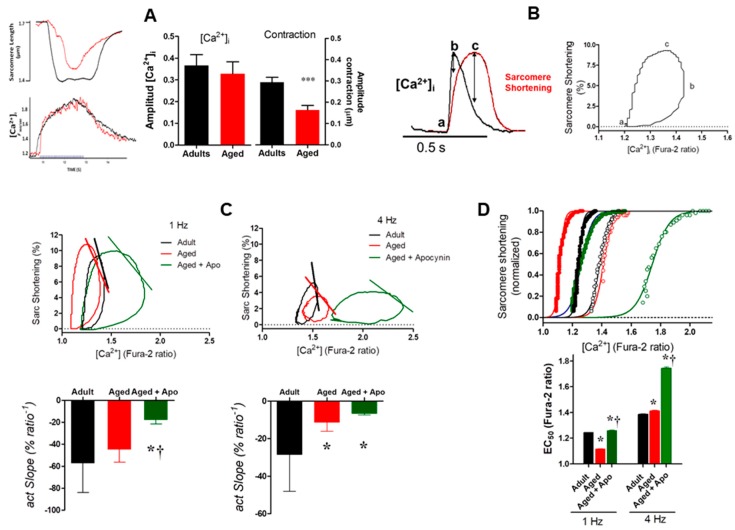Figure 4.
Myofilaments Sensitivity. (A) Using thapsigargin to block SERCA activity, myocytes were submitted to tetanic stimulation (40 Hz) to evaluate the myofilaments Ca2+ sensitivity. (Left panels): contraction (up) and the [Ca2+]i evoked by tetanic stimulation. (Right panels): pooled data for the amplitude of contraction (evaluated as degree of sarcomere shortening) and the amplitude of the cytosolic Ca2+ concentration evoked by tetanic stimulus in adult and aged cardiomyocytes. *** p = 0.0002. N = 20 cells from adult (n = 3) hearts and 29 cells from aged hearts (n = 3). (B) Phase loop analysis for the sarcomere shortening-[Ca2+]i relationship. Example of hysteresis analysis of Ca2+ vs. sarcomere shortening for a normal twitch. The segment from a-b represents the Ca2+ activating phase, the b–c segment represents cross-bridge feedback, and the a-c segment represents the relaxation phase. (C) Hysteresis loops used to obtain the slope of the activation phase at 1 and 4 Hz. (D) sarcomere shortening-[Ca2+]i in the activating phase fitted to the Hill equation to obtain the EC50, the Ca2+ concentration that activates the 50% of the maximal shortening (normalized). The filled symbols represent determinations obtained at 1 Hz of stimulation; the open symbols represent determinations obtained at 4 Hz of stimulation. N = 14 adults, 16 aged and 11 aged + apocynin cells for experiments at 1 Hz; 9 adult, 9 aged, and 7 aged + apocynin cell for experiments at 4 Hz. * p < 0.001 vs. adult. † p < 0.001 vs. aged.

